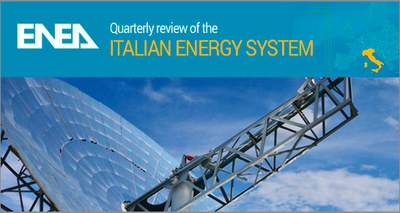Energy: Consumption + 3%, renewables + 2% in Italy
19/7/2018
In the first quarter of 2018 final energy consumption in Italy increased by 3% compared to the same period in 2017, with the civil sector recording the highest increase (+ 4.5%). In terms of energy sources, renewables returned to growth (+ 2%) thanks to the recovery in hydroelectric generation (+ 11%). This is what emerges from the ENEA quarterly analysis of the Italian energy system which highlights a growing trend in energy consumption in industry (+ 2%, in line with industrial production) and unchanged levels in transport despite growing traffic indicators.
 "The more than double increase in final consumption compared to the economic growth of the period, was pushed by the civil sector due to a colder winter than the previous one", Francesco Gracceva, the ENEA expert who coordinated the analysis, explained.
"The more than double increase in final consumption compared to the economic growth of the period, was pushed by the civil sector due to a colder winter than the previous one", Francesco Gracceva, the ENEA expert who coordinated the analysis, explained.
Among the primary energy sources the use of solid fuels was again reduced (-5%), now at the tenth consecutive trend decline on a quarterly basis, while natural gas, driven in particular by consumption for heating, recorded a 1% increase. With the new increase in primary electricity consumption (+8%), the recovery phase consolidated after the 2011-2014 contraction and the stagnation of 2015-2016.
As for prices for companies, there were increases for diesel and a drop in electricity. In particular, the average price of diesel increased by 2.5% compared to the same period in 2017, making it the highest in the European Union, even after taxes. Gas prices for Italian companies rose sharply in all the consumer segments in the quarter, due to the increase in the cost of raw materials, with an average increase of 8% compared to the period September-December 2017. However, it is estimated that this increase will be offset by an equivalent reduction in the second quarter of this year. Similar trends also for electricity prices, which also affected the reforms relating to system charges.
"According to our preliminary estimate – Gracceva explained - the average cost of electricity paid by high- consumption companies would drop by 5% in mid-2018, with a presumable improvement in terms of competitiveness. System cost reforms, on the other hand, would have marginal effects on medium-low consumption companies. In view of this, in the first six months of the year a slight increase in the price of electricity for households is estimated (+ 0.7% compared to the previous semester), mainly due to the increase in the 'system charges' component in the electricity bill, due to the the tax cuts granted to energy-intensive companies ".
A 7% decline of the ISPRED Index, developed by ENEA on the basis of energy security, prices and CO2 emissions, was mainly due to the decline of the decarbonisation component (-14%). "CO2 emissions were substantially unchanged compared to the same period in 2017, despite the significant growth in energy consumption. On the other hand, however, this stagnation of emissions consolidated a trend less and less in line with long-term objectives. In fact, a significant decrease in emissions in electricity generation in the last two quarters corresponds to an increase in emissions in the civil sector and in industry, and to an unchanged figure in transport. Also for renewable sources, a substantially stationary trajectory seems to be consolidating, not in line with the growth targets for the share of RES on final energy consumption by 2030”, Gracceva continued.
The ISPRED component related to energy security appeared unchanged compared to a year ago, thanks to significant improvements in the gas system indexes (+ 10%) and to more marginal progress of the indexes relating to the electricity system. "However, some of the critical issues due to energy transition remain unsolved, both due to the risk of excess production from intermittent sources in the south and on the major islands during the summer and to a new decline in the profitability of natural gas plants, with the spark spread that summarizes the profitability, returned significantly below 10 € / MWh ", Gracceva pointed out.
Lastly, the ISPRED component relating to prices was substantially stable (+ 1%), as a result of the combination of the significant decline of diesel fuel and an equally significant improvement in electricity for businesses.
"In the first half of the year, despite a phase of rising oil and gas prices, the Italian energy system maintained a trajectory of consumption growth, which does not seem to be in line with the decarbonisation targets; at the same time, there was an improvement in electricity prices and an amelioration of some critical issues which had emerged last year regarding the safety of electrical systems and natural gas ", Gracceva concluded.
